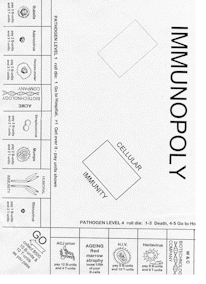Fall 2000
 Page 4
Page 4
Bill Beachly
Students need to be challenged to think outside
the familiar formats, and motivated to apply what they’ve learned in a
non-threatening environment. This is why I make games for many of my biology
courses. Most often these are played in the laboratory because the seating
is more adaptable, set-up is easier, and time is more flexible. In this
note I hope to encourage others to design games for their curricula, as
I have found students most receptive to the novelty.
The first step, as you think about the nature of the material being covered, is to decide if it reminds you of any games you know. It is usually easier to design a game around a format that may already be familiar to students. Relatively obvious, and simple, formats are games such as Trivial Pursuit, or the popular TV game shows Jeopardy and Who Wants to be a Millionaire*. But with computer graphics programs and photocopiers it is possible to mimic (as the sincerest form of flattery, of course) popular board games.
I am an assistant professor in Biology at Hastings College (enrollment around 1100). My courses include Principles of Biology (a two-semester major's course), Mathematical Biology, Human Physiology, Ecology, Animal Behavior, and Invertebrates. Fortunately, I have interests in all of these topics!
Bill
Beachly
Hastings College
7th & Turner
Hastings NE 68901
 Take
Monopoly for example. Using a computer drawing program it was easy
to make a one page outline of 1/4 of the game board layout (you know,
the avenues and corners). Then I pasted on my own text and drawings to
create Immunopoly. Just as the point in Monopoly is to get
around to GO again without going broke; in Immunopoly you try to
get around without getting sick, or killed. Rather than landing on properties
and paying rent, you land on pathogens and must fight them off with white
blood cells. Where in Monopoly you may come to own a property and
needn’t worry about landing there again; in Immunopoly you can
overcome an infection and gain lasting immunity to that particular pathogen.
Of course the familiar jail and "go to jail" corners are now
the hospital and "go to hospital" corners. The "chance"
and "community chest" cards have been replaced by "humoral
immunity" and "cellular immunity" cards; and the railroads
are now biotechnology companies with which players may patent their own
gamma globulins or develop their own vaccines to sell to other players.
In Monopoly the rents get higher as you go around, until the dreaded
Park Place and Boardwalk are finally passed with relief. In Immunopoly
the pathogens are increasingly dire and it is not at all uncommon for
students to die (several times are permitted, based on how you want to
play the game). In short, much of the Monopoly rubric is adapted
to your course’s material. This same adaptation can be applied to other
games and courses.
Take
Monopoly for example. Using a computer drawing program it was easy
to make a one page outline of 1/4 of the game board layout (you know,
the avenues and corners). Then I pasted on my own text and drawings to
create Immunopoly. Just as the point in Monopoly is to get
around to GO again without going broke; in Immunopoly you try to
get around without getting sick, or killed. Rather than landing on properties
and paying rent, you land on pathogens and must fight them off with white
blood cells. Where in Monopoly you may come to own a property and
needn’t worry about landing there again; in Immunopoly you can
overcome an infection and gain lasting immunity to that particular pathogen.
Of course the familiar jail and "go to jail" corners are now
the hospital and "go to hospital" corners. The "chance"
and "community chest" cards have been replaced by "humoral
immunity" and "cellular immunity" cards; and the railroads
are now biotechnology companies with which players may patent their own
gamma globulins or develop their own vaccines to sell to other players.
In Monopoly the rents get higher as you go around, until the dreaded
Park Place and Boardwalk are finally passed with relief. In Immunopoly
the pathogens are increasingly dire and it is not at all uncommon for
students to die (several times are permitted, based on how you want to
play the game). In short, much of the Monopoly rubric is adapted
to your course’s material. This same adaptation can be applied to other
games and courses.
Another example that we played in a 2000 ABLE mini-workshop was Where in the Brain is the Nucleus Accumbens, based on the popular TV geography show Where in the World is Carmen Sandiago? This game involves the whole class, working in teams to follow clues on a series of large posters (representing different regions of the brain) that may ultimately lead them to the Nucleus Accumbens. The clues are riddles that test their understanding of CNS anatomy and function. This is a game that can be played in a lecture room or laboratory.
The point is to show that you can use your imagination to produce a nice activity, and with the tools at our disposal your game can look quite like the "real thing". Students will appreciate the effort and creativity you put into it, and they often teach each other quite a bit in the process of playing. This is a wonderful thing to watch! It is also a refreshing surprise to students when they come to lab and find a game board set up for them. You can be quite flexible in the time you allow for this, sometimes it can fill those time gaps that occur in traditional labs: such as waiting for the gel to run. And there’s no limit to your subject material. Dr. Kari Benson at Lynchburg University shared an exercise with me in which her students had to design their own "life history" game for an ecology class. She received many creative and fun game ideas and I’m sure the students thought more deeply about life history theory than they would have otherwise.
 Watch
in the ABLE 2000 proceedings for photocopy-ready masters that will allow
you to make and play Immunopoly and Where in the Brain is the
Nucleus Accumbens. Meanwhile, think about games for the courses you
teach and share your ideas via Labstracts!
Watch
in the ABLE 2000 proceedings for photocopy-ready masters that will allow
you to make and play Immunopoly and Where in the Brain is the
Nucleus Accumbens. Meanwhile, think about games for the courses you
teach and share your ideas via Labstracts!
*Tom
Fogle of Saint Mary's College attended the board games workshop and pointed
out how easily this game can be adapted for class reviews. I've recently
played it in lecture as Who Wants to be an M&Ms Winner?![]()
ã 2000 ABLE. All rights reserved.